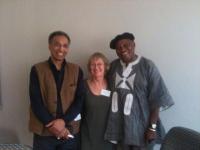Posted on November 21, 2011

Opening the seminar was Gavin Jantjes, the project director of the publication. He describes the volume as 'series of stories'Â and goes on to suggest 'History is a horror in the South African experience if you cannot recognise yourself in its stories. There is no history without memory. Memory facilitates how we remember. Telling our own stories is fundamental to our democratic and human action.'Â
The volume is constructed from numerous research seminars. 'We were aware we were collecting clashing cultures,'Â Jantjes adds. The context of the books is built around four timelines, namely 1907-1948 (volume 1), 1945-1976 (volume 2), 1973-1992 (volume 3) and 1990-2007 (volume 4). The compilers were seeking a layering of different voices, which would allow readers to understand the history of art from the various narratives.
The histories told in the books are not the first accounts of South African art, but they certainly are alternative narratives. It is not so much a re-writing, as rather the expanding of knowledge on the visual history of South Africa. In a way, the project signifies a move away from the grand, one-voice history of the canon. The lived experience of the arts remains hidden if one does not offer alternative narratives of the South African archive.
As a seminar, the discussion then took a life of its own. Acting as a discussant, Professor Pitika Ntuli noted the absence of black artists at the seminar itself. He suggested that their absence illustrates a 'timidity of black artist, that is potentially paralysing'Â. He then went on to elaborate on the notion of inclusivity, which demands a reaching out to different people, to their gods, and their ancestors.
Jillian Carmen said, 'The focus has to be local, in the sense that these are our stories'Â. The concerns of art history in the international world are very different from our local concerns. Gavin Jantjes suggested that visual literacy be given the same level of importance that is given reading and mathematic literacy. He recalled a moment in his childhood, when he first went to an art centre: 'This was the first time that nobody told me what to do,'Â he said. Therein lies the power of creativity and its centrality to growing. Precisely because reading and mathematics are enabled by a prior experience of looking, visual literacy begins the primary skill that allows other literacies to emerge.
An audience member responded to the panel, by reminding them that 'In every black home in this country you will find something hanging on the wall - whether it is a magazine image of Michael Jackson, or an image of a black mother and child.'Â This was testimony to the fact that South Africans do have a visual culture, but that it is simply not being harnessed to meet the needs of public engagement. It is a fact that most art collectors in the country are white.
Although we may have made significant in-roads in expanding the circle of artists in the country, with many young and older black artists receiving acclaim - such as Pitika Ntuli himself, but also Mary Sibande and Nandipha Mntambo, as young black female artists on the art circuit today. Our challenge remains expanding the circle of the 'visualising project'Â, which by its necessity implies building a local culture of art viewing and patronage. There remains much to be excavated in the visual archive of South Africa, but this needs to be coupled with a public '˜visual'™ culture. From the discussion that unfolded at the seminar it is clear that this would be what determines if the Visual Century project is a success or not.
Other speakers who made a contribution in the seminar include Ciraj Rassool, Mario Pissarra (editor-in-chief) and Ari Sitas.
Thokozani Mhlambi is an Archival Platform Correspondent.
See also the text of the address delivered by Verne Harris, of the Nelson Mandela Centre of Memory, at the Johannesburg launch of the Visual Century, 10 November 2011